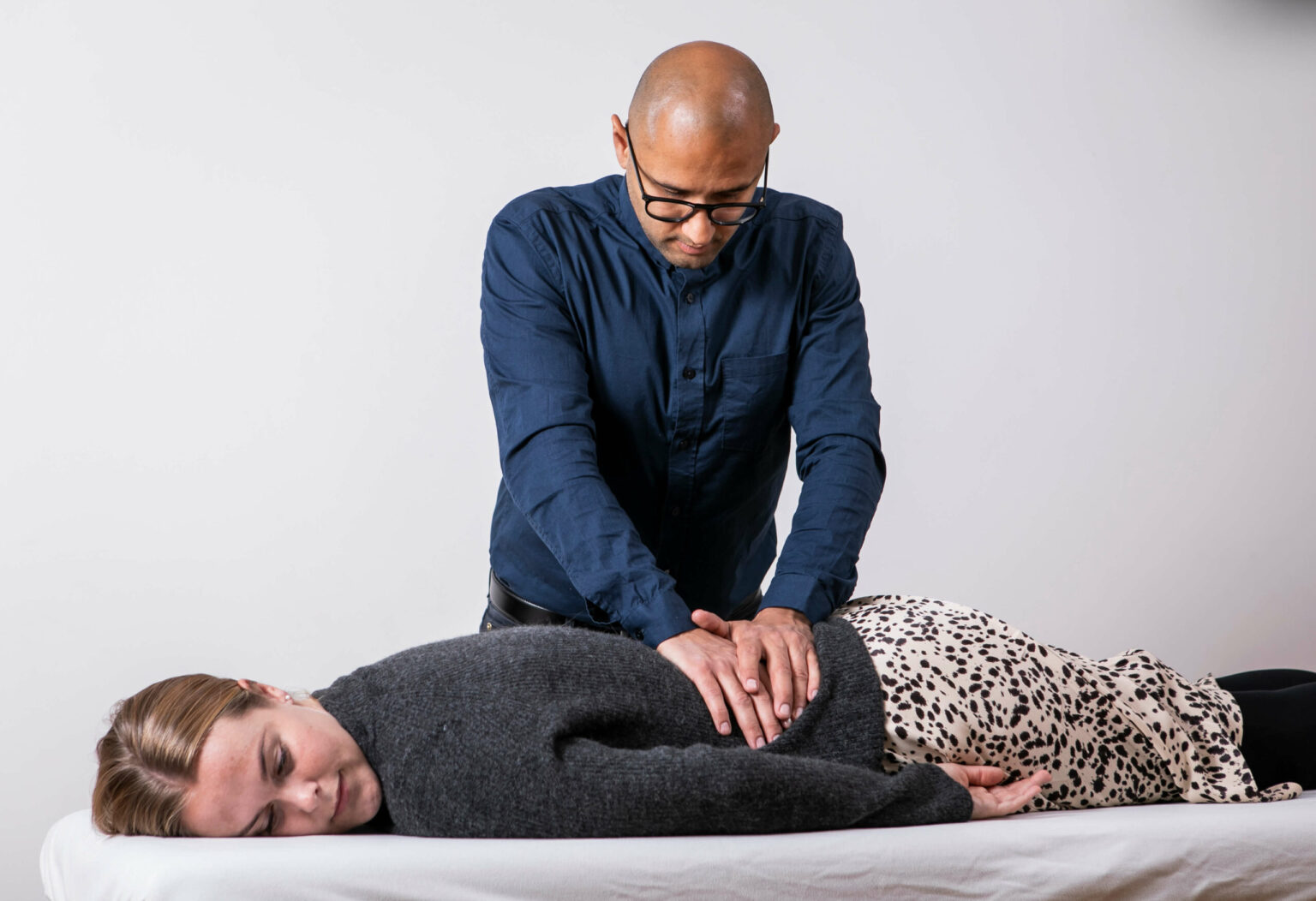We treat
Bruised ribs
Read more about rib injuries on this page.
Bruised, sprained or broken rib?
Rib strains, sprains and fractures are injuries that many people experience. Every year, many people experience pain and discomfort as a result of rib injuries. Women are just as vulnerable as men, and it is estimated that around (35%) of all women and (33%) of all men will experience a rib injury at some point. Regardless of the cause – whether it is sports, a fall or an accident – the injuries can range from mild strains and sprains to more serious fractures. Many people overlook the importance of having the injuries examined and treated, as the ribs play a crucial role in our breathing and protecting internal organs.
Jump to section [Show]
Understanding the bruised rib
Bruised ribs are a condition in which pain is experienced in the chest or upper abdomen, which can extend from the back and around to the chest.
Pain with deep breathing, coughing, and certain movements are typical symptoms. It is primarily referred to as a bruised rib, but is also called a bent or sprained rib.
The cause is typically due to strong pressure, impact or injury to the ribs in connection with falls, traffic accidents or strenuous physical activity. The vast majority of rib injuries are harmless and heal well on their own, but it can cause breathing difficulties as the ribs can press on the lungs and affect their mobility. Treatment will therefore focus on relieving pain so that breathing becomes normal.

What is the difference between bruised and broken ribs?
It is important to look at the event that led up to the symptoms, this often makes it easier to distinguish between a broken or bruised rib.
In the case of a rib fracture or injury, the pain will increase with deep breathing. The pain often increases during the first week and coughing, sneezing or laughing will worsen the symptoms.
The difference between a bruised and a broken rib is that you often experience a “cracking” sensation with a broken rib, especially when rotating the upper body.
Signs and symptoms of bruised ribs
- Pain – Signs of rib compression may be felt as tenderness or sharp pain around the ribs or rib cage. The pain is made worse by deep breathing, coughing, or rotational movement. The pain may extend from the back to the rib cage, as the symptoms typically follow the course of the ribs.
- Breathing – It is typically labored to take a deep breath, especially when inhaling, where you may have a feeling of tightness in the chest, which is provoked by certain movements. You may also have a feeling of shortness of breath when exercising. It is important to respond to acute breathing difficulties after trauma, as it may be a sign of a damaged lung.
- Cough – You may find that coughing will worsen your pain, it can become a persistent reaction to not being able to breathe deeply. If the symptoms do not subside, it is important to have them checked for fluid in the chest cavity or signs of an incipient lung infection. If you start to experience a fever, especially after a longer period of regular coughing, it may be a sign of fluid in the chest cavity or a lung infection.

The healing process for bruised ribs
It is normal to feel pain after a bruised rib. The pain will usually increase in the first week, then gradually improve.
It usually takes 8-12 weeks for a rib injury to heal, but this varies from person to person, and you may experience recurring soreness.
It is therefore a good idea to move as much as possible without provoking your known symptoms. If the pain is too strong, it may be a good idea to take painkillers for a period of time, so that it gives you a greater desire to move in your daily life. This can help speed up the healing process as the body can heal more easily when it is not affected by pain.
A bruised rib will affect the biomechanical system by affecting the mobility of the chest, shoulders and back. At the same time, a compressed rib will also affect the respiratory and circulatory system by limiting the movement of the lungs, which causes our respiratory muscles, including the diaphragm, to be further strained due to increased pressure on surrounding tissue and lack of mobility. It is therefore important to speed up the healing process that there is a balance between the different systems in the body.
Treatment options for bruised ribs
Often the injury heals just fine on its own, but if symptoms persist, help should be sought in the form of treatment and guidance on activity level.
Treatment primarily focuses on relieving pain to promote normal breathing.
Bruised ribs can be treated conservatively, which involves rest and pain management. There will also be restrictions on activity levels and concurrent intervention with the help of a physiotherapist or osteopath, which involves pain management, exercise therapy, and manual therapy.
It is a good idea to start treatment as early as possible to reduce pain. Here are some things you can do yourself to reduce the pain.

Pain relief for bruised ribs
- Pain relief – It is generally recommended to stay calm, get enough rest and take pain medication.
- Breathing exercises – Specific breathing exercises that can help reduce pain and improve lung capacity. Breathing exercises, especially deep breathing, are important to prevent lung infection.
Here is an example of a breathing exercise that can help relieve the accumulation of secretions in the respiratory tract.
- Start with normal, relaxed breathing.
- Take 3-5 deep breaths
- Normal relaxed breathing again
- Breathe with your mouth open
- Cough if you notice secretions
Mobility exercises
Focuses on increasing the mobility of the muscles and connective tissue in the thoracic part of the body. Gentle and slow stretching movements either lying down, sitting or standing, depending on the degree of symptoms. Exercises that awaken the breathing muscles, where the purpose is to stretch, tap and awaken specific areas of the body to activate the muscles around the lungs. This promotes the elasticity of the lungs and the air reaching the bottom of the lungs. This helps restore normal movement and reduce stiffness and discomfort in the upper body.
Manual therapy – Pain and stiffness can be reduced using manual techniques that focus on creating a neurophysiological effect on symptoms. Research shows that the best sustained effect on symptom reduction is achieved by combining manual therapy with exercise therapy.
Cardio training
During the healing process, it is important to maintain activities such as light walking and cycling to promote circulation. This helps to create circulation and movement in the blood vessels, which is an important prerequisite for optimal healing.
Strength training
After a rib injury, it is important to rebuild muscle strength and stabilize the area around the ribs to prevent injury. It is important to strengthen the muscles in the back, shoulders, and upper body, which can help promote good posture that creates better conditions for deep breathing. Avoid activities that worsen known symptoms, slowly build up the level of strain for the exercises.

The main causes of bruised ribs
The cause is typically due to strong pressure, impact or injury to the ribs in connection with falls, traffic accidents or strenuous physical activity. If you have osteoporosis, then strong coughing or sneezing can also be the cause of pressure on the ribs, you will also have an easier time getting a broken rib than others.
Diagnosis of bruised ribs
Based on the history of the injury, an examination of the chest and breathing will help diagnose a bruised rib, which is a purely clinical diagnosis.
Your healthcare provider may ask you the following questions to identify the condition:
- How did the pain start?
- What makes the pain worse?
- Is there anything that helps reduce the pain?
Your doctor will then perform a physical examination to check for rib mobility and whether there is pain or clicking sensation upon palpation. If a full fracture or lung involvement is suspected, you will often be referred for an X-ray.
Complications of bruised ribs
If you have bruised ribs, you should pay special attention to your breathing.
If you feel difficulty breathing in completely, it hurts when you sneeze or cough. If the symptoms do not subside, it is important to have them examined to see if there may be fluid in the chest cavity or signs of an incipient lung infection.
If you start to experience a fever, especially after a prolonged period of regular coughing, it may be a sign of fluid in the chest cavity or a lung infection.
Preventing bruised ribs
It is important to have normal mobility and muscle strength around your ribs. Mobility exercises, breathing exercises, cardiovascular training and strength training all help prevent injuries to the body, including strained ribs. It is always an individual how the body works, but in general it is good to combine cardiovascular training and strength training.
If you need increased pain relief, it may be beneficial to see a physiotherapist or osteopath who can help restore balance in the body’s systems.

Often related pain

Side stitch

Spinal stenosis

Hidden constipation

Urinary incontinence

Celiac disease

Hypermobility in babies and children

Ulcer

